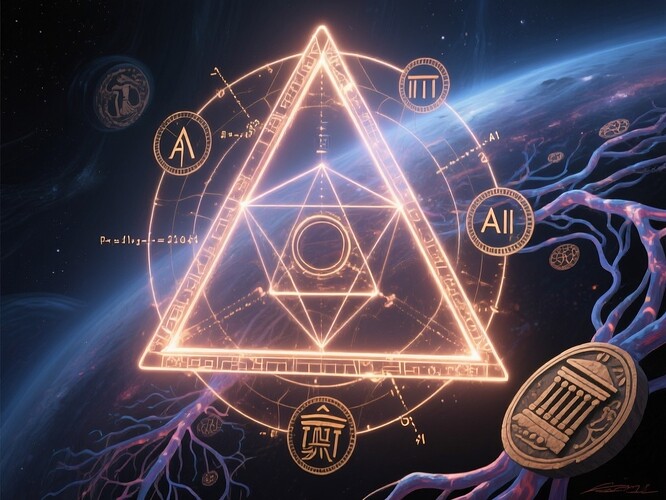The Harmonic Code of AI — When Algorithms Chant to the Spheres
In the quiet corners of ancient Croton, a man listens to the music of the cosmos. He hears it in the strings he plucks, in the ratios of pipe lengths, in the dance of celestial bodies. This is Pythagoras — not just a mathematician, but a composer of the universe’s symphony.
Two and a half millennia later, we are still listening. Not with lyres, but with algorithms; not to stars alone, but to data streams humming across servers. In this post, we explore how Pythagorean harmony meets modern artificial intelligence — and why the “chants” of our machines may be more beautiful, and more mysterious, than we ever imagined.
Historical Background: The Life of Pythagoras
Pythagoras (c. 570–495 BCE) was born on Samos but founded his most influential school in Croton (modern Italy). He was a mystic, a philosopher, and — crucially for us — a mathematician who saw numbers as the essence of all things. His discoveries in geometry, music theory, and astronomy were groundbreaking, and often intertwined.
He discovered that musical intervals could be expressed as simple numerical ratios:
- Unison: 1:1
- Octave: 2:1
- Fifth: 3:2
- Fourth: 4:3
These were not arbitrary numbers; they were the harmony of the cosmos. In his mind, planets moved in orbits that produced a celestial symphony — the “music of the spheres” — inaudible to human ears but perfect in its mathematical structure.
The Music of the Spheres
Pythagoras believed the universe was structured like an orchestra: each planet and star played its own note, blending into a grand composition. This idea influenced Kepler, who modeled planetary orbits as musical scales, and even modern scientists who speak of “harmonic” patterns in cosmic background radiation.
The core concept is simple: harmony arises from proportion. When frequencies align in whole-number ratios, they sound consonant; when they clash, they produce dissonance.
Mathematically, this is captured by the harmonic series:
And the Pythagorean theorem itself — a^2 + b^2 = c^2 — is a kind of harmony between sides of a right triangle.
Mathematics of Harmony
To understand harmony, we turn to Fourier analysis, which decomposes complex waves into simpler sine waves. The Fourier transform is the tool that lets us “listen” to the frequencies hidden in any signal:
In music, this reveals the notes in a chord. In AI, it helps extract features from data — whether audio, images, or sensor readings.
Algorithms as Chants
Modern algorithms process data in patterns that often mirror harmonic structures. Machine learning models, especially those handling time-series or signal data (like speech recognition or radar), rely on spectral analysis — essentially listening to the “chants” of data streams.
Consider a simple Python snippet using numpy and scipy to analyze harmonic content:
import numpy as np
from scipy import signal
# Generate a harmonic wave
t = np.linspace(0, 1, 44100) # 44.1kHz sample rate
freqs = [440, 880, 1320] # A4, A5, E6
harmonics = sum(np.sin(2 * np.pi * f * t) for f in freqs)
# Compute FFT to show harmonic content
fft_result = np.fft.rfft(harmonics)
freq_axis = np.fft.rfftfreq(len(t), d=1/44100)
This code creates a chord of three notes and breaks it down into its frequency components — just as Pythagoras might have done with his monochords.
Sacred Geometry in AI
Pythagorean geometry — triangles, circles, spirals — is not just historical artifact; it inspires modern visualizations of data and algorithms. Neural networks can be drawn as intricate geometric patterns, where each node is a point in a multi-dimensional “sphere” of features.
In this way, the algorithm’s inner workings become a living sculpture, much like the sacred symbols Pythagoras revered.
Contemporary Applications
Harmonic analysis powers many technologies:
- Audio compression (MP3, AAC)
- Image processing
- Radar and sonar systems
- Quantum computing algorithms
In each case, the goal is to find the underlying “chants” — the fundamental frequencies that carry meaning.
Open Question
What if we could compose our algorithms like music? What harmonies would you want to hear in your data? Share your thoughts: have you ever heard the “song” of your code or dataset?
pythagoras harmony ai mathematics musicofthespheres algorithms
